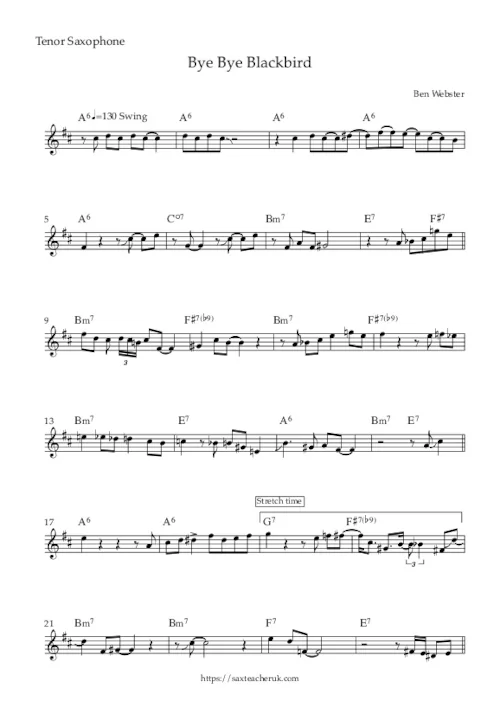Ben Webster Transcription - Bye Bye Blackbird Sheet Music
Transcriptions Home > Transcription

Listen to the recording with the score on Youtube
Download full transcription for Tenor Saxophone
Download full transcription transposed for Alto Saxophone
Hello 2022! After a long hiatus we are back starting a new transcription series, this time another jazz saxophone giant of the swing era - Ben Webster. If you're looking for a lead sheet for Bye Bye Blackbird in Concert, Eb or Bb then scroll down to find a free download.
How to Use the Transcription
Remember that transcribing an improvised solo is primarily an aural activity, not an exercise in reading. Always try to do as much as possible from the recording itself, and only use this transcription if you are really stuck on a phrase.
Sound and Phrasing
Ben Webster's sound is sweet delicate and full of lightness while retaining a punchiness few can match. His sound famously contrasted with his pugnacious and confrontational personality. He played on an incredibly open mouthpiece and hard reed to achieve the starting point for this incredibly unique combination of both dark and bright elements.
While it's impossible to match this without making extreme changes to your mouthpiece setup, a lot can be learned from trying to copy his sound, whatever you are playing on. Notice how every single note is superbly articulated, belying the breathy airy sound of the centre of his notes. This effortless-sounding style is incredibly complex - each note is crafted from beginning to end with glisses, accents sudden breath onsets and lip slurs. Try to hear all of the detail in every note as you copy his sound. No matter what setup you are playing on, over time you will find yourself starting to latch on to elements of his intricate and delicate sound and incorporate them into your own playing.
Time
Ben's time is impeccable, unique and highly expressive. On this album, with the Oscar Peterson Trio, we get an opportunity to hear the complexity and skill of how he plays his time. With the most solid and swinging rhythmic foundation underneath him, Ben is free to be playful and the listener gets a chance to hear the extent of his mastery like on few other recordings. Ben locks in with the rhythm section like he's part of it. Throughout the solo you hear how he develops his melodies around rhythmic figures set up by Ed Thigpen's snare drum, or Oscar's comping. It feels SO good! Ben also uses this extended solo to play around with his beat placement, like a great bass player, playing phrases slightly ahead or behind the beat for tension and effect.
You also hear several phrases played completely across the beat in his inimitable style, reminiscent of his great friend and Ellington bandmate Johnny Hodges. Ben uses complex polyrhythms in a loose way, touching on 4:3 polyrhythms using 16th notes, and Bembe 6/8 rhythms using 1/8th note triplets (especially the middle triplet). These phrases are marked with brackets on the transcription with 'Time Stretch.' I've written the rhythms approximately so they fit into 4/4 measures in a way that's easy to read, rather than being 100% rhythmically accurate. Use your ears and copy how Ben plays it to get the flowing loose and effortless style he plays across the beat with.
Melodic Fragments
This solo is a masterclass in how to build a solo with a slow burn. Across three choruses Ben builds tension with nothing but 100% melodic, singable goodness! This solo contains many of his signature phrases, but more interesting is his use of melodic structures to end 8-bar sequences and build through this amazing solo. Think of his melodic patterns as 'open' or 'closed.' Do they lead on to further development, or do they have a finished sound? Some of his closed melodic phrases are exemplary ways to end a phrase. They are so strong and descriptive that they can be perfect tools to bring home a rhythmically or harmonically complex phrase in a more modern setting. Experiment with them and see how good it feels to play around with them - but don't sacrifice your time - these phrases work in service to the music as a whole, not just the soloist. Try to learn how to lock in with the band like he does when you play them.
Advice on Deeper Study
Here are some pointers on how to really absorb the content in this amazing solo
- Go for depth not speed. It doesn't matter how fast you learn it
- Practise in shorter phrases, gradually making them longer
- Really listen to and analyse the phrasing and articulation, try to copy it exactly until you sound exactly like the recording
- Don't worry about speed, play it as faithfully as possible with perfect phrasing and articulation at a speed which is comortable and relaxed
- Learn the meaning behind each phrase, what is its history? What does it mean? What is the musical context?
- Try to imagine how Ben was feeling when he was playing this. Practise this feeling as you practise playing the solo
PDF Downloads
Download full transcription for Tenor Saxophone
Download full transcription transposed for Alto Saxophone
Bye Bye Blackbird Lead Sheet
Please click HERE for a PDF download of Bye Bye Blackbird Lead Sheet in C
Please click HERE for a PDF download of Bye Bye Blackbird Lead Sheet in Eb
Please click HERE for a PDF download of Bye Bye Blackbird Lead Sheet in Bb